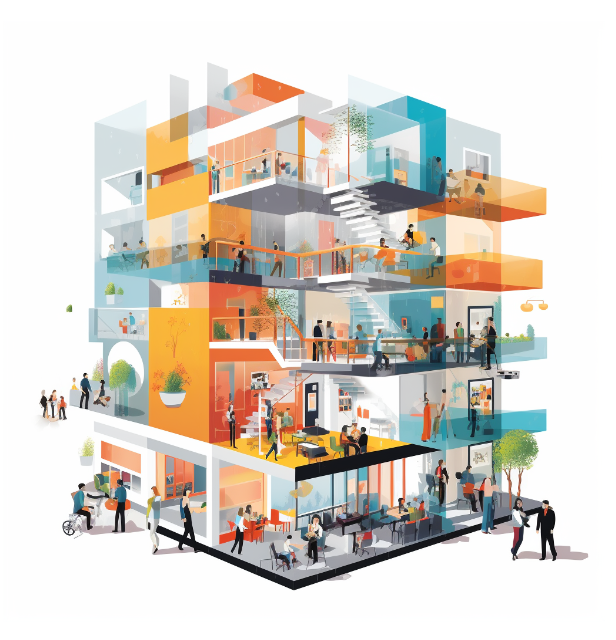- Home
- Planning for Building Adaptability and Multi-Use Spaces
Planning for Building Adaptability and Multi-Use Spaces

Let’s face it – buildings can be pretty inflexible. Once constructed, the floorplan is set in stone, right? Well, not necessarily. With thoughtful design, buildings can actually be super adaptable to changing needs.
As an architect, I’m fascinated by structures that can flex and bend to serve different uses over time. Nothing depresses me more than seeing an abandoned building falling apart when it could have had a second life with some smart renovations.
In my experience, the best buildings are designed from the outset to be like old sweatpants – flexible, durable, and able to adjust as needed. With moveable walls, convertible spaces, and versatile building systems, properties can actually accommodate all sorts of uses during their lifespan.
In this post, I’ll walk through the benefits of designing adaptable spaces and share some key strategies to consider. We’ll take a peek inside some cool adaptive reuse projects that gave new life to old buildings. I’ll also provide some tips on how to future-proof buildings for optimal flexibility down the road. Let’s dive in!
Benefits of Adaptable Building Design
Creating adaptable spaces isn’t just about being trendy – there are some major benefits:
Financial – Buildings that morph to meet changing needs hold their value and generate income for longer. Adaptable design is a smart investment.
Sustainable – Breathing new life into existing buildings conserves resources. It’s way greener than demolishing and starting from scratch.
Community – Historic and culturally-significant properties can often be adapted to suit modern needs while retaining their charm. This preserves community heritage.
Future-ready – Designing for flexibility leaves options open for uses not yet envisioned. Adaptive buildings can roll with the punches as needs evolve.
Experience – Spaces that can modify to changing activities or work styles provide a better user experience. Form follows function.
Lower vacancy – The ability to repurpose a building makes it easier to fill vacancies as demands shift. Adaptive design minimizes periods of disuse.
The small upfront investment needed to allow for flexibility pays back over the full lifecycle of a building. It’s worth going the adaptable route.
Key Factors to Consider
Certain design choices promote long-term flexibility:
Modular layouts – Movable interior walls and consistent floor heights allow for easy reconfiguration. Think interchangeable Lego bricks rather than permanent glue.
Movable building blocks – Incorporate partitions, furniture and storage units that can shift around like puzzle pieces. Murphy beds and fold-down tables maximize multi-use.
Accessible utilities – Distribute and make accessible the guts of a building – HVAC, electrical, plumbing. This enables easy system upgrades and additions down the road.
Durable materials – Choose finishes that can withstand heavy use and frequent reconfigurations. Avoid anything too bespoke or high-maintenance.
Lighting – Flood the space with natural light to make it suitable for different uses. Reflective surfaces bounce light deep into the floor plate.
Future-proof tech – Include spare power capacity and conduits for easy electrical upgrades. Think 5G-ready.
Case Studies of Adaptive Reuse
Now let’s look at some cool examples of adaptive reuse in action:
Industrial to Hip Hangout – One urban developer transformed an old industrial warehouse into a bustling community arts center. The brick exterior and timber beams were kept to maintain the building’s gritty character. Skylights and floor-to-ceiling windows washed the space in natural light. An open floorplan allowed for flexible zones that could host art exhibitions, performances, coworking space, café, and gathering areas. Talk about multi-use!
House of Worship to All-Purpose Venue- A decommissioned 19th century cathedral found new life as a vibrant community events center. The sanctuary became a grand hall for conferences, forums, and even roller derby bouts! Adjoining chapels were converted to meeting and activity rooms. Pews were repurposed as funky lobby furniture, while the kitchen was upgraded to commercial grade. Now that’s divine transformation!
Office Building to Vertical Farm – One innovator converted an old office tower into a futuristic vertical farm. Lush greens grow under LED lights on rotating racks to maximize productivity. An automated hydroponic system nourishes plants while aquaponics tanks fertilize with fish waste. Rooftop solar panels provide renewable energy. Now that’s an adaptive reuse for the future!
Planning for Future Uses
When designing new buildings, how can we “future-proof” them for flexibility? Here are some tips:
See the future – Consider how uses could change and design to allow for conversion, expansion, and multi-tenant occupancy.
Core strength – Reinforce the structure and locate fixed elements like stairs and plumbing strategically to leave floor plates open.
Layer on extras – Incorporate additional restrooms, exits, and mechanical systems to enable future subdivision into different zones.
Think generations – Use quality materials and building systems that will perform for decades with proper maintenance.
Leave room to grow – Acquire extra land around the building to allow for physical expansion when needed.
Build in versatility – Distribute utilities throughout and make them readily accessible. Include extras like spare power capacity.
Conclusion
Adaptable buildings just make sense – they can morph and flex to fulfill changing needs rather than ending up abandoned and obsolete. By designing strategically for long-term flexibility, properties can have much longer life cycles.
Simple choices like modular layouts and movable components make buildings easily reconfigurable. Investing in quality and leaving room for growth future-proofs buildings to serve new uses not yet envisioned.
Adaptive reuse projects breathe exciting new life into outdated building stock. Seeing the potential within languishing structures takes vision but the payoff is huge.
Next time you design, build or renovate, think adaptability! Empower buildings to smoothly evolve along with their occupants and community. That’s truly building for the future.
Author Bio
Wimgo
Other post in Categeory
© 2022 Wimgo, Inc. | All rights reserved.